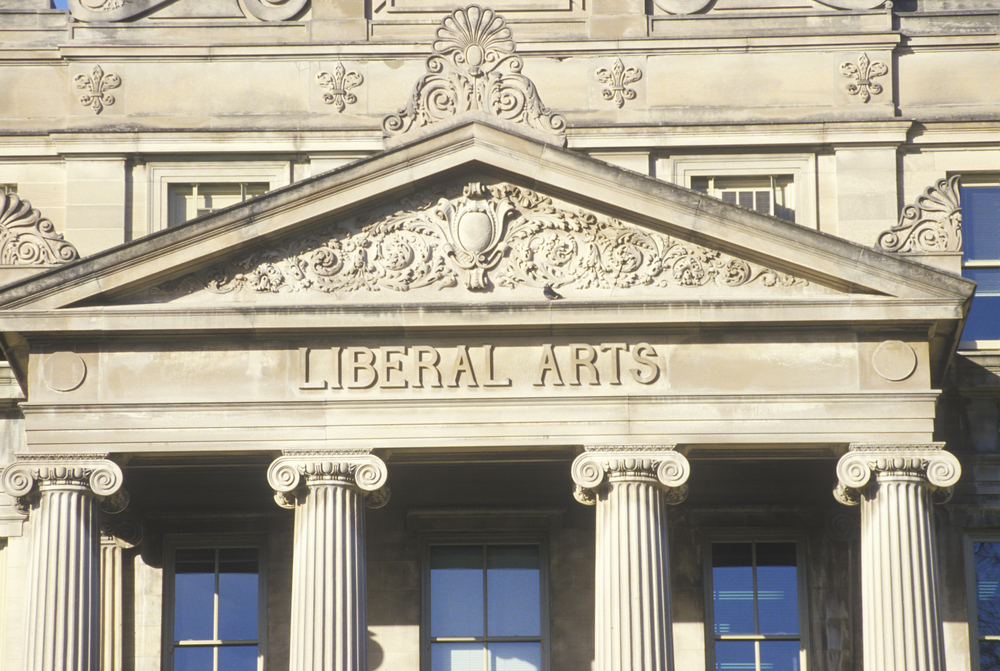For those of us who’ve devoted out lives to the liberal arts, it’s all too common to encounter doubters. As a high school English teacher, I encounter this all too frequently. Naturally, I’ve developed my own arguments, and because my interlocutors are teenagers, I’m usually successful at persuading them of the value of what I’m teaching them. However, once they enter college, the combined pressure from their parents and the surrounding culture will force them to “put away childish things” like The Scarlet Letter and replace them with more “adult” majors such as business or the sciences.
The consequent decline in liberal arts programs has prompted numerous defenses from more than a few liberal arts instructors. Some, like George Anders in his book You Can Do Anything: The Surprising Power of a “Useless” Liberal Arts Education, make a practical case for the liberal arts, arguing that the kind of critical thinking that happens in these courses can be paired with some technical skill to result in a lucrative career. Others, like Mark Bauerlein in The Dumbest Generation Grows Up, make a philosophical case for the liberal arts, claiming that they protect students from radical ideology and make them more well-rounded human beings.
Although these defenses have merit, neither of them really offers persuasive ideas for reform. Anders simply assumes that the humanities are fine the way they are and need only a boost from positive thinkers like himself. Bauerlein is well aware that most humanities programs have succumbed to gimmicks and politics, but that the real enemy isn’t so much the culture but the screen. Accordingly, his outlook is bleak, particularly for millennials (my generation) and the generations following them.
With that said, there’s certainly a place for someone else to enter the academic arena and continue fighting the good fight. With his new book, The Death of Learning: How American Education Has Failed Our Students and What to Do About It, humanities scholar John Agresto makes his own contribution to the debate. While he approaches the topic somewhat grimly, recognizing the many failures that have occurred on so many college campuses, he is still steadfast in defending and promoting the humanities. More importantly, he does this eloquently and fastidiously, avoiding affectation and cloying sentimentality.
Agresto begins his argument by discussing his own introduction to the liberal arts. Like most people, he wasn’t always a Great Books expert. He went through Brooklyn Catholic schools, didn’t like reading, and showed little ability to understand great texts like the Iliad—his English instructor called him a “damn fool” to his face (more than once). His father only supported his studying the liberal arts after a nun intervened on his behalf (also more than once).
Years later, after becoming the president of St. John’s College in Santa Fe, he was embarrassed by William F. Buckley in a discussion over whether everyone should learn the liberal arts. Buckley, “one of the most liberally educated men one might meet,” took the view that the liberal arts are good only for some people, not everyone. Many years later, Agresto concedes that he ultimately failed to “give a satisfactory response to whether the liberal arts were right for everyone.”
Not only does this background explain Agresto’s motivation in writing the book but it gives him a grounded perspective on the liberal arts. He rightly sees the problem as more a case of self-destruction: “This beautiful project [the liberal arts] died not from old age, nor only from neglect and not exactly from murder, but from self-inflicted wounds that look a bit like suicide.”
Much of this stems from failing to define properly the liberal arts in the first place. Agresto notes how many schools like to claim the title “liberal arts college” or boast how they merge the liberal arts with STEM. Other schools have taken liberal arts to mean something too narrow (e.g., “Homoerotic Themes in Contemporary Poetry”) or too broad (anything involving critical thinking), further muddying the waters. In both cases, it makes little sense to major in the liberal arts when it’s unclear what students are expected to gain. If they want to learn something specific, they may as well choose something remunerative, and if they want to develop basic thinking skills, they can pretty much go with anything that strikes their fancy.
Unlike most conservative critics, Agresto doesn’t necessarily mind the efforts to broaden the curriculum to make it more multicultural and inclusive. When he brings up the infamous episode of activists protesting the Western Civilization course at Stanford, he does this to illustrate how the goal for the social justice warriors was to subtract, not to add: “It wasn’t ‘Let’s read more minority writers!’ but ‘Hey, hey, ho, ho, Western Civ has got to go.’”
Agresto does, however, criticize the efforts to indoctrinate (teaching what to think instead of how to think) and the steady erosion of educational standards that proceeded from the war against Western Civ. Rather than teach students to question and develop arguments, professors discouraged this and instead cultivated good conformists who had the right opinions. Along with this were movements across the country to remove great thinkers from curricula, usually dead old white males, and censor all dissident views from public discourse.
After laying out the problems, Agresto eventually makes good on his promise to offer some solutions. Understandably, he starts with restoring the original understanding of what constitutes the liberal arts, which would replace the usual work of “learning about” great thinkers with “learning from” the great thinkers. For Agresto, this means getting to the truth offered by those thinkers rather than either over-contextualizing them or condemning them outright. This in turn leads to students’ approaching great texts with wonder, asking big questions. Finally, by reading and writing in the right spirit, liberal arts students become formidable thinkers themselves who can “confront [their] own opinions and refine them … untangle a mass of confusing arguments … enrich [their] imaginations” and have “clarity and precision in writing.”
Judging from his own experience, Agresto acknowledges that any possible reform must come from the top down: “It will take leadership—leadership from the presidents, provosts, and deans; leadership from those parts of the university that have an interest in the reform and promotion of traditional education; leadership from alumni and trustees; and leadership from donors.” While perhaps true, it makes the conclusion of his book somewhat anticlimactic: What about the people who aren’t leading campuses? What about us teachers and freelance writers who care about what becomes of the liberal arts?
Fortunately, Agresto speaks to this group in the appendix essays, particularly “A Message to High School Teachers and Principals.” Far from being replaceable cogs in the educational machine, we are the often the main vessels for passing on a truly liberal education to the next generation: “If your students do not get an education under your tutelage, they almost certainly will never get one.” It’s up to us high school teachers to expose the younger generations to the great texts and teach them how to learn from such books.
Too bad these types of educators are so rare. As sympathetic as I am to Agresto’s vision, he doesn’t seem to appreciate the many obstacles faced by today’s educators in implementing the liberal arts/Great Books agenda. I saw this firsthand over a decade ago when I took courses tailored for K–12 teachers that introduced them to the Great Books at the Dallas Institute of Humanities and Culture. It was an amazing experience for us all, and by the end of each course we wanted to spread the joy of a true humanities instruction to our campuses; some of the program directors even set up humanities academies at local public schools. Sadly, nothing took root. Either unsupported or outright rebuffed, we returned to our usual habits, and the humanities instruction has continued to diminish into something useless and uninspired.
By recounting this experience, I don’t mean to denigrate Agresto’s case in The Death of Learning or in the accompanying essays. His argument is much more realistic and clear-eyed than most writers on this topic. For those of us making an honest effort to learn from the Great Books, his criticisms and proposals offer some reason for hope and continued effort. Moreover, his expertise manifests itself in his exceptional prose, which is clear, elegant, and tasteful. He’s able to reference classic texts and make them relevant, showing what’s possible when one studies such classics. In practicing what he preaches, he proves that the liberal arts really do make one a good writer and thinker.
Perhaps not surprisingly, I share Agresto’s optimism about reforming and reviving the liberal arts. Since they’re the basis of learning, any effort to improve a moribund education system requires their restoration. We’re well past the point of searching for solutions in new technology or various novelties in course curricula (like the College Board’s misbegotten African American Studies course); such trends always come to nothing and waste so much money. Instead, we should try the one obvious thing that costs us nothing and offers so much: teaching the liberal arts and rediscovering their greatness.

